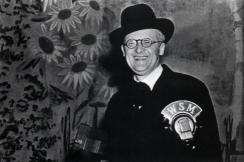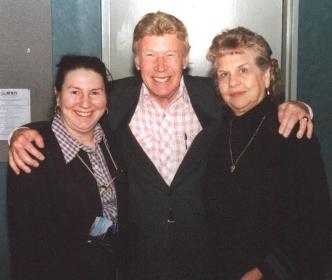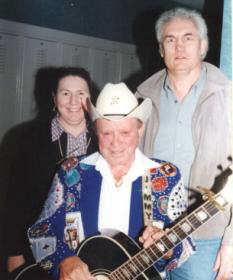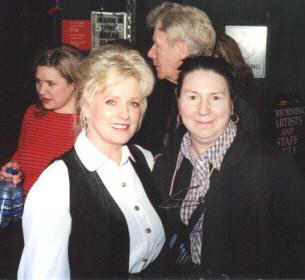|
It was the age of jazz and the "Roaring Twenties".
All across America, people were buying radio sets by the thousands,
eager to hear the new "miracle" that brought entertainment
directly into their own living room. The creator of WSM was Edwin W.
Craig, who had joined his father's company, the National Life and
Accident Insurance Company as a field representative and by 1922 had
risen to the level of vice-president. It was around this time that
Craig began tuning into the pioneer radio stations, which were
popping up around the country. In time, he was soon convinced a
radio station would enhance National Life's identity while also
providing a valuable public service to the community. The board of
National Life readily agreed, with Craig taking charge.
It was decided that the station's call letters would be
"WSM", to reflect National Life's motto: "We Shield
Millions." Unfortunately, the U.S. Navy had already been
assigned those letters. Undeterred, Craig successfully petitioned
the Secretary of Commerce to transfer the call letters and as a
result WSM Radio was born and the longest and most successful
country radio program, the Grand Ole Opry started life.
 |
|
George
D Hay
|
George D. Hay of Chicago's WLS was a 30-year-old former
newspaperman who worked under the pseudonym "The Solemn
Old Judge". With a keen wit, George Hay was hired on
as the station's first Program Director within a month,
staying with the program until he retired in 1953. Hay wasted
no time in creating new shows. While the station relied
mostly on classical and dinner music for its programming,
on the night of 28th November 1925, all that changed forever.
WSM's Barn Dance (a spin-off of Hay's National Barn Dance
program from his previous Chicago radio station) on Saturday
night was becoming one of the most popular programs on radio.
The prestigious title "Grand Ole Opry" came from
Hay in 1927. The program at the time was three hours long
and followed NBCs Musical Appreciation Hour of classical
music, conducted by Dr. Walter Damorosch. While introducing
a number in the program, Damorosch commented "while
most artistes realise that there is no place in the classics
for realism, I am going to break one of my rules and present
a composition by a young composer from Iowa. This young
man has sent us his latest number, which depicts the onrush
of a locomotive." When the WSM hillbilly music came
on air, Hay announced, "While there was no room for
realism in the classics, the following three hours would
be devoted to nothing but realism. In a good-natured jibe
at Damorosch, Hay introduced one of the show's most popular
performers, Deford Bailey, a black harmonica player who
then played the train song 'Pan American Blues'. When the
performance was over, the Solemn Old Judge announced, "for
the past hour we have been listening to music taken largely
from grand opera, but from now on we will present The Grand
Ole Opry." So, the legend was born!
Listeners were invited to come to WSM Studio A, at the
National Life Building for the live broadcast to play and, or listen
and come they did. In fact within two years so many people turned up
at the small National Life studio that a new auditorium Studio B
soon had to be built to accommodate the overflowing crowds. "We
Shield Millions" had rapidly become "We Seat Many".
The Opry was moved into a succession of three venues, each larger
than the next. The Hillsboro Theatre, the Dixie Tabernacle and then
the War Memorial Auditorium were all home to the Opry. A 25-cent
admission fee was even charge in hopes of curbing the large crowds,
but it was to no avail. The numbers continued to average 3,000 or
more and the move to the Ryman Auditorium in 1943 was a welcomed
necessity.
 |
|
Crowd
outside the Ryman
|
The Ryman Auditorium first opened its doors in 1892
as a revival church, a vision of Captain Thomas Ryman. With
the coming of the Grand Ole Opry show in 1943, the Ryman
found its identity as the Mother Church of Country Music.
In 1974, the Opry moved to it's current home the 4,400 seat
Grand Ole Opry House, leaving the Ryman vacant. It was not
until 20 years later in 1994 that the Ryman was restored
to be the national showplace that it is today. Musicians
ranging from Roy Acuff to Hank Williams to Trisha Yearwood
have performed on the Ryman stage, making it a historical
as well as a current day icon for people everywhere. The
Opry announced it would return to the historic Ryman Auditorium
for limited engagement during the months of January and
February. For the past two years the Opry revisited its
previous home, performing to sell out crowds and hosting
performances by its most celebrated members and special
guests.
Over the years a whose who of country artistes have joined the
cast of thousands on the Grand Ole Opry stage. The King
of the Opry, Roy Acuff first appeared there in 1937 performing
his now famous 'Great Speckled Bird'. It wasn't as rousing
as he had hoped for, but Acuff was invited back in 1938
and after his performance generated sacks full of mail he
was offered a regular spot. Roy is also the only Opry member
to have his own dressing room backstage at the Opry. When
President Richard Nixon attended the premier performance
the new Opry House in March 1974, joining the cast on the
world famous stage, Roy Acuff had a little fun teaching
Nixon the intricacies of the YoYo.
 |
|
Graham
& Marlene With bronze likeness of
Roy Acuff & Minnie Pearl in The Ryman Auditorium
|
The Queen of the Grand Ole Opry was 'Cousin' Minnie Pearl, one
of country music's most beloved and prominent hicks. Born Sarah
Ophelia Colley Cannon, and dressed in her calico dress and flowered
straw hat with the famous price tag of $1-99 dangling from it,
Minnie Pearl joined the Opry in 1940. Developing her character as
the girl from Grinder's Switch who was forever trying to "ketch
a feller", she would walk on stage with a loud "Howdee!
I'm just so proud to be here." Sadly Minnie Pearl suffered a
stroke and passed away in March 1996 a few short months before being
inducted into the Country Music Hall Of Fame. Today a young woman
dressed in similar cloths to Minnie Pearl greets and howdies the
crowd as they patiently wait outside for the doors of the Grand Ole
Opry to open for the evening shows.
As the Grand Ole Opry grew in popularity even Hollywood took
notice, and in 1940 Republic Pictures produced The Grand Ole Opry, a
full-length feature film starring Judge Hay, Uncle Dave Macon and
Roy Acuff along with other members of the Opry cast.
From Ernest Tubb, to Eddie Arnold, to Hank Williams Snr, to
Garth Brooks to Reba McEntire, country music stars have at one time
or another all played the Grand Ole Opry. Hank Williams made his
first appearance in June 1949, being such a great hit that he
received an unprecedented six encores after singing 'Lovesick
Blues'. Unfortunately Elvis Presley wasn't as lucky. After
auditioning, he was told by Opry Manager Jim Denny, to go back to
driving trucks, as he would never make an Opry artiste.
 |
|
Marlene with
Ernie
& Bettye Ashworth
|
Today the Grand Ole Opry is still broadcasted as radio
program on Saturday nights. There are two shows on Saturday
and one on Friday evening. Both of the Saturday programs
are broadcast live with the Friday recorded show slotted
in between first house and second house performances. Sponsorship
comes from companies such as Coca-Cola, Martha White flour,
Physicians Mutual Insurance, Cracker Barrel restaurant chain
and many other national and local companies, with the announcements
made live right on stage, just as they were in the early
days of The Grand Ole Opry. A fine book is on sale at the
Opry - "Grand Ole Opry Picture History Book",
containing photos of all the current Opry members, plus
yesterday's stars.
It is a tradition and an honour for artistes to be asked to
join the Opry cast. Many artistes still see
 |
|
Little
Jimmy Dickens with
Marlene & Graham
|
the Grand Ole Opry as the home of country music and
many of today's country stars such as Dolly Parton, Vince
Gill, Trisha Yearwood, George Jones, Alan Jackson, Martina
McBride, Steve Wariner, Travis Tritt, Charley Pride, are
pleased to appear on the Grand Ole Opry stage. Porter Wagoner
is still one of the biggest supporters along with Bill Anderson,
Little Jimmy Dickens, Jan Howard, Jeannie Seely and Jean
Shepard. Other regulars on the Opry stage include John Conlee,
The Whites, Jim Ed Brown, Jimmy C. Newman, Mel McDaniel
and Ernie Ashworth, remember 'Talk Back Trembling Lips'
from 1963…Ernie is still gaining considerable success on
Europe's EMS charts at present. In March there was featured
An Opry Tribute - The Women In Country featuring Lorrie
Morgan, Tammy Cochran, Pam Tillis, Martina McBride and Loretta
Lynn which was recorded for CMT who aired the TV program
over the following days. The Grand Ole Opry can also be
heard on the Internet at www.opry.com on Friday and Saturday
nights.
 |
|
Connie
Smith with Marlene
|
Early 2002 Gaylord Entertainment Company the current
owners of the Grand Ole Opry announced that they intended
to make WSM an all sports program, therefore after 77 years
of broadcasting every week, the Grand Ole Opry as we know
it would be drawn to a close. During my time in Nashville
recently, several comments were made regarding the negative
response received by Gaylord from people all over the world,
protesting that the Grand Ole Opry was being taken off air.
I understand they received over 10,000 emails protesting
about the format change, plus thousands of telephone calls
encouraged this multi million-dollar company to change their
minds.
While talking to Opry newcomer Brad Paisley early in 2000, he
told me "I've played the Grand Ole Opry 25 times in the last 9
months. I'm very very committed to the Opry and I'm there every
weekend that I'm off. If I'm at home on a Friday or Saturday I will
play the Opry. I never don't play it, unless they are over booked or
it is a last minute thing. They have been very wonderful to me and
the Opry members have treated me like a son and taken me under their
wing. I've become very good friends with Bill Anderson, Little Jimmy
Dickens and Porter Wagoner, Del Reeves, Jean Shepard and Jeannie
Seely. I think it's because they revere me and see a little of
themselves in what I do, because of their influences. Incidentally I
cut a Bill Anderson number last week on my new album that we're
working on. I take it really serious that I pay homage to those
folk."
With this sort of sentiment from the new breed of artistes,
hopefully the Grand Ole Opry and WSM will live on for many years to
come!
|


![]()